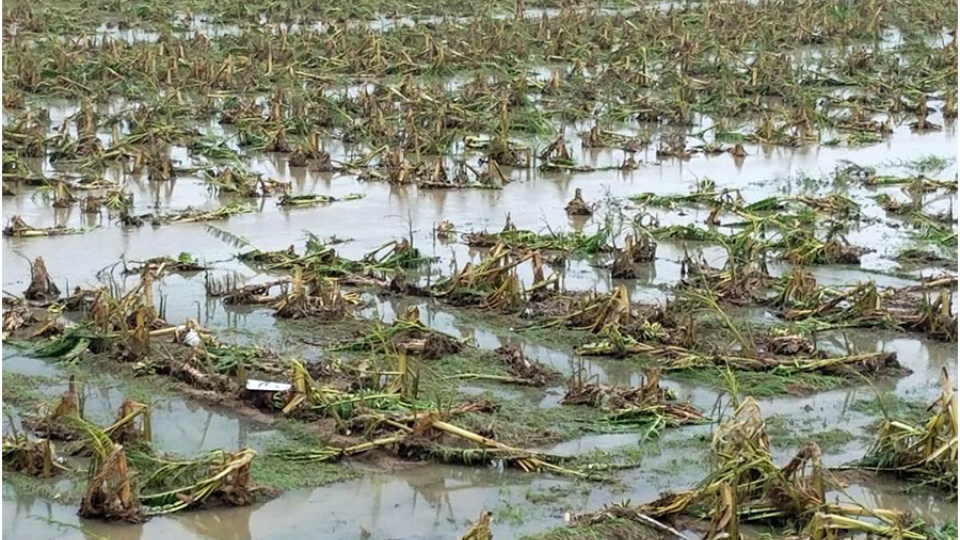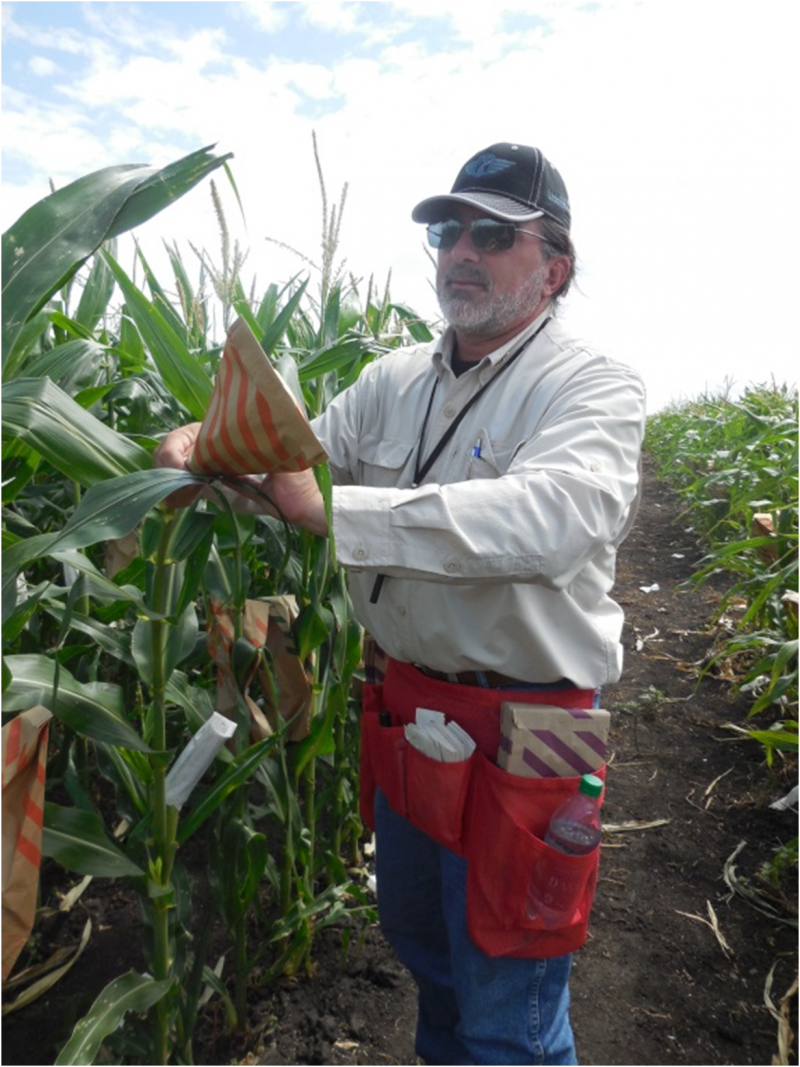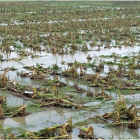On a hot day in late July 2014, Ed Baumgartner met me on the research plot belonging to his company, 3rd Millennium Genetics LLC (3MG), just outside Olivia, Minnesota. I learned how to cross-pollinate an ear of corn and about the significance of a daily logbook for closely monitoring the breeding research. The book tracks the date each row on the research plot was planted, when the first tassels appeared, and on what day they were pollinated with pollen from another corn variety. The logbook notes how each plant performs and what its special features are, such as “wide leaves” or “tall stalk.” Out of the many plants in the research plot, only a tiny fraction of the experimental crosses will end up as commercial corn varieties and will be produced on large scale. “We throw away 98 percent, 99 percent of what we do. I mean, that’s the way it is,” Baumgartner says. The high number of discards shows that even though humans have selected corn for over 6,000 years, hybridized it since around 1900, and genetically modified it since the 1990s, it is still not possible to predict with certainty the outcome of crossing two strains of corn.
The reason why this time-consuming, expensive undertaking is still worth the effort, when only 1 percent of the experimental crosses turns into commercial varieties, has to do with the fact that corn is America’s number one cash crop and therefore there is much money to be made from it—in 2017, the value of the US corn harvest was estimated at $47.5 billion. Much of the research and development for hybrid and genetically modified corn varieties comes out of the US. Baumgartner’s 3MG is one of the few small companies in a market mostly dominated by large seed businesses. 3MG’s Midwestern hometown, Olivia, is home to a total of 14 seed research and production facilities. Because of this cluster of seed companies, it calls itself the “Corn Capital” of the USA.

Corn research plot in Olivia, Minnesota, showing the different features of corn plants in the research stage, with bagged ears of corn (to prevent cross-pollination).
Corn research plot in Olivia, Minnesota, showing the different features of corn plants in the research stage, with bagged ears of corn (to prevent cross-pollination).
Photograph by Annka Liepold, 29 July 2014.
 This work is licensed under a Creative Commons Attribution 4.0 International License.
This work is licensed under a Creative Commons Attribution 4.0 International License.
But how does the prospect of continued climate change affect the work of corn breeders? Climate change leads to a rise in global temperature and an increase in extreme weather conditions. This means that plant varieties must be adapted to prosper even in extreme weather conditions, such as drought, extreme heat and cold, hail, etc. This is why corn breeders will never develop the “perfect corn variety”—as conditions keep changing, they will keep adapting the plants. It takes on average 10 to 15 years from the first experiments in the research plot to having a market-ready variety. Therefore corn breeders must anticipate what the growing conditions will be like by the time their products hit the market.
Thinking about the future of corn means engaging with its past. To develop new varieties, breeders often go back to old varieties, which are kept in seed banks, to see if they possess certain traits that are helpful in tackling problems posed by extreme climate conditions. When hybrid corn seeds were introduced on a large commercial scale in the US in the 1930s and 1940s, they pushed out most open-pollinated corn varieties. However, with the spread of hybrid corn, breeders realized that the loss of the open-pollinated varieties could be devastating for future breading endeavors, as they needed a large variety of strains to work with. To ensure that varieties would be available in the future, seed banks were created in the 1930s. It was the potential commercial value of old varieties that led to them being saved—rather than a concern for biodiversity.

Crop damage caused by Hurricane Maria in Puerto Rico.
Crop damage caused by Hurricane Maria in Puerto Rico.
Photograph by U.S. Department of Agriculture.
Click here to view Flickr source.
 This work is licensed under a Creative Commons Public Domain Mark 1.0 License.
This work is licensed under a Creative Commons Public Domain Mark 1.0 License.
But climate change does not only impact what varieties will be available in the future; it also directly impacts the current breeding process. Almost all US-based seed breeders have tropical research plots as part of their operation to speed up the research process, as they can plant up to three crops per year in tropical locations—compared to just one in the Midwest. The increase in extreme weather phenomena particularly affects these research stations in the tropics. The Baumgartners’ second research station is located in Santa Isabel, Puerto Rico. In recent years the island has been hit more frequently by hurricanes that have left behind severe destruction. Hurricane Maria in September 2017 ripped out plants, washed away soil, and destroyed much of the island’s infrastructure, including the research stations. This is why in 2017 the Baumgartners could only use one out of their two Puerto Rican farms to start their winter research planting. Other plant breeders faced similar losses. In the aftermath of the hurricane, seed companies with multiple tropical research plots opted to switch to alternative facilities in Chile, Hawaii, or Argentina. The destruction of research plots due to the hurricane disrupted ongoing research projects. This could potentially lead to a delay in getting new corn varieties ready for the market. As tropical storms are becoming more frequent, seed breeders will have to find a way to deal with the consequences this has for their tropical research locations.
So, on the one hand, climate change places new demands on corn plants, and corn breeders are trying to create varieties that will best meet the challenges posed by extreme weather conditions in the future. On the other hand, the research into these new varieties is directly impacted by global climate-change phenomena, especially on the tropical research plots that face destruction through hurricanes.
How to cite
Liepold, Annka. “Breeding for the Future: Corn and Climate Change.” Environment & Society Portal, Arcadia (Autumn 2018), no. 27. Rachel Carson Center for Environment and Society. doi.org/10.5282/rcc/8497.
ISSN 2199-3408
Environment & Society Portal, Arcadia
 This work is licensed under a Creative Commons Attribution 4.0 International License.
This work is licensed under a Creative Commons Attribution 4.0 International License.
2018 Annka Liepold
This refers only to the text and does not include any image rights.
Please click on an image to view its individual rights status.
- Clampitt, Cynthia. Midwest Maize: How Corn Shaped the U.S. Heartland. Heartland Foodways. Urbana: University of Illinois Press, 2015.
- Kloppenburg, Jack R. First the Seed: The Political Economy of Plant Biotechnology, 1492–2000. 2nd edition. Madison: University of Wisconsin Press, 2004.
- Curry, Helen Anne. “Breeding Uniformity and Banking Diversity: The Genescapes of Industrial Agriculture, 1935–1970.” Global Environment 10, no. 1 (2017): 83–113. doi:10.3197/ge.2017.100104.









